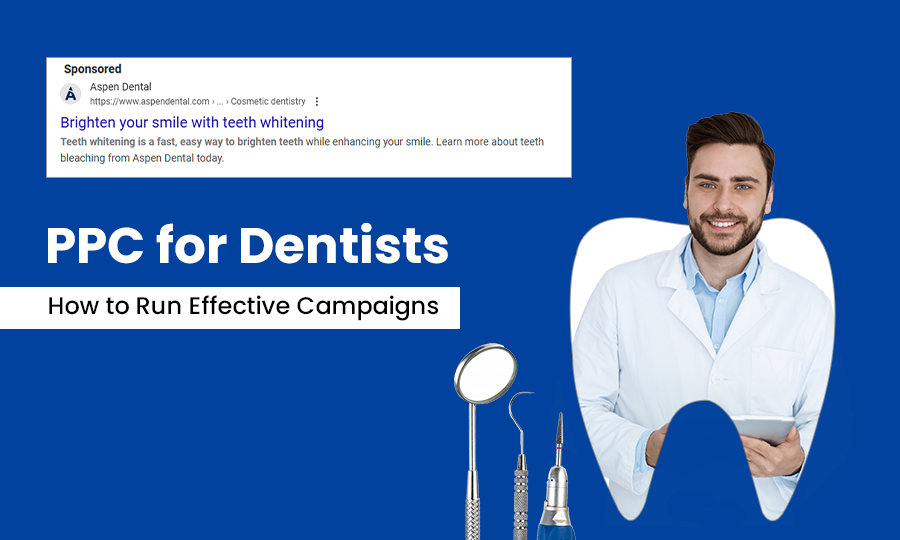Spending thousands on PPC ad campaigns, but not seeing results? Many dentists face this challenge. Running PPC ads without the right setup will ultimately lead to disappointment and failure. This is where PPC for dentists comes into play.
Now you might think, ‘Why do I need to invest in PPC ads when there are other options available?’ PPC traffic converts approximately 50% better than organic search.
By developing and executing effective PPC ads, dentists can not only make their business stand out from others but also get noticed by new patients. This blog will discuss how dentists can successfully create high-performing ads and the types of platforms where they can run their ad campaigns.
So let’s get started.
What is PPC for Dentists
PPC Advertising is a digital marketing strategy where dental practices often have to pay a fee every time someone clicks on their ads.
This strategy allows dentists to display their ads on search engines such as Google and Bing and social media platforms like Facebook, Instagram, and LinkedIn. These ads appear when people search for a term that is closely related to dental practices.
For instance, suppose someone searches for “Teeth Whitening services” or “Best dentists near me,” then PPC ads for relevant dental clinics pop up in the Search Engine Results Pages.
6 Reasons Why Dentists Must Invest in PPC Ads
There are several reasons why dentists must invest in PPC ads. We have listed a few of them for you.
- Hyper-Focused Marketing
These ads allow dentists to follow a targeted approach and guarantee maximum profits from their campaign efforts. Dentists can modify their campaigns to attract patients based on age, gender, location, and interests.
- Ad Budget Control
In PPC, you have to pay only when someone clicks on your ad, which makes sure you do not spend an unnecessary amount of money on your ad campaign, allowing dentists to have complete control over their ad campaign’s budget.
- Immediate Visibility
The best part of PPC ads is that they offer instant visibility. In comparison to digital marketing strategies such as SEO and SMM, PPC ads can start to appear on the search engine result pages as soon as your campaign comes into effect, bringing in traffic to your website right away.
Your prospective patients will be able to see the dental services or treatment you offer by searching for relevant keywords such as “best dentist in London” or “emergency dental care near me.”
- Measurable Results
PPC platforms offer valuable insights, such as Cost Per Click (CPC) and conversion rates. These data allow dentists to effortlessly track how their ads are performing and determine what is working so that they can adjust their strategy to get better results.
A Comprehensive Guide to Effective PPC Ad Creation for Dentists
Here are some of the best strategies you need to consider creating high-converting dental PPC ads for attracting more traffic and enhancing conversion rates.
Strategy 1: Understand How a Dental PPC Campaign Works
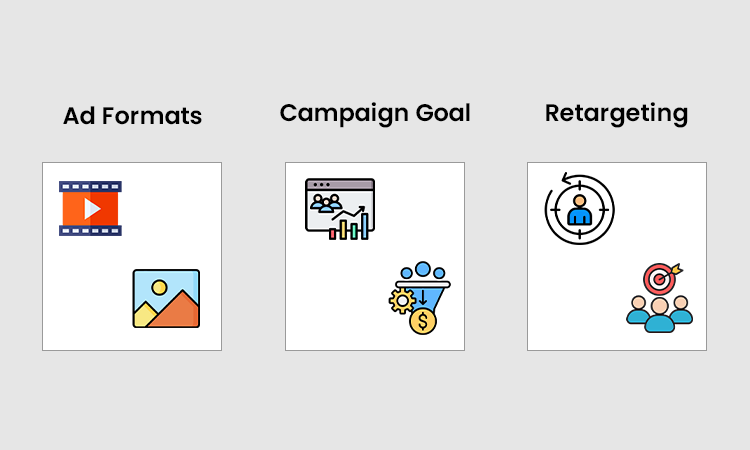
Pay-Per-Click (PPC) is a form of digital marketing where advertisers pay a fixed amount each time someone clicks on their ads or visits their website. The main idea of a PPC campaign is to buy clicks for a particular website.
The objective of PPC for dentists is to make patients take action, like booking a consultation or scheduling an appointment.
These ads are solely based on keywords. For example, in search engines, your ads appear only when someone searches for terms or phrases related to your business.
Therefore, businesses that depend on PPC ads research and determine the keywords that perfectly align with their products and services.
What is Google Search Ads?
These are keyword-driven ads that appear on search engines when someone searches for “dentist near me” or “teeth whitening services in Chicago.”
Google search ads usually appear across Google’s Search Network at the top and bottom of the page, or beside the search results in Google Play, Google Maps, Google Search, and more.
What are Meta Ads?
Meta ads are targeted advertisements that are shown to users on these platforms. They make use of demographic data, geographic location, and interest to reach specific audiences, which makes them effective for promoting products or services while enhancing brand awareness. Here is a detailed explanation of Meta ads.
- Hyper-focused Advertising: Facebook and Instagram leverage a huge amount of user data to help advertisers target specific demographics, behaviours, and interests.
- Ad Formats: These include videos, pictures, or carousels that appear in the user’s stories and feeds.
- Campaign Goal: You must make sure to set a campaign objective. Whether you want to maximize website traffic, enhance conversion rates, and generate high-quality leads.
- Retargeting: Do not forget your past audiences. Make sure to show your ads to audiences who have previously engaged with your practice’s website and social media.
Strategy 2: Set Clear Campaign Goals
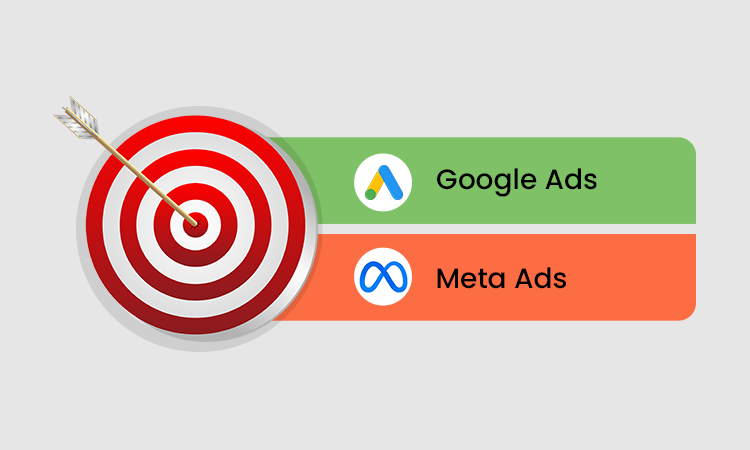
A clear goal is crucial for the success of your PPC ad campaign. Dentists must have a deep understanding of what they desire to achieve through their ad campaign. Do you want to get more appointments, more calls, or more form submissions?
Setting up a clear objective can help dentists personalize their campaign to achieve their business goals. This is one of the most important steps to get started with PPC for dentists.
Are you done setting up a goal? Then it is time for you to choose the right type of campaign.
Google Ads:
- Local Service Ads: These ads are great for dentists with a physical location or service area looking to attract local patients. These ads can help dentists drive more foot traffic, leads, as well as website traffic.
- Search Campaigns: This type of ad is suitable for reaching out to prospective patients who are actively looking for your products or services. These text-based ads frequently appear on SERPs, which makes them great for driving more traffic and leads.
- Performance Max: These campaigns often leverage banner ads across various networks of apps and websites. Performance Max allows you to reach a broader group of audience and establish solid brand awareness.
- Display Campaigns: An AI-powered campaign that can help you enhance conversion and value by optimizing across various Google Ad channels.
Meta Ads:
- Lead Generation
This campaign especially focuses on achieving user information such as email addresses, contact information for future follow-ups. or promotions.
This is an ideal type of campaign for businesses that are looking to broaden their database of leads through forms for demos and newsletters.
Best practices for lead generation campaigns:
- Make sure to keep the form as simple as possible and ask only for necessary information.
- You should offer something valuable to your audience, like a special discount, to encourage them to sign up.
- Ensure to incorporate targeted follow-up messages or emails to keep leads engaged even after the form submission.
- Video Views
This campaign type encourages your audience to watch video content. Great for businesses that implement product demonstrations, storytelling, or educational content to interact with audiences.
Video Views campaign enables businesses to establish a close connection, especially with audiences who prefer video content.
Best practices for Video Views campaigns:
- Keep the videos crisp, concise, and interactive, especially in the first few seconds.
- Many people watch ads with sound turned off. Make sure to include subtitles to captivate their attention.
- Add an engaging CTA at the end of the video to help viewers proceed with the steps.
- Reach
The Meta Reach campaign type is designed to increase the number of people who view your ad, making it appear in front of as many viewers as possible within your target audience.
This type of campaign is suitable for businesses that are looking to achieve higher visibility for an event or promotion of a specific treatment, product, or service.
Reach campaign best practices:
- You can incorporate frequency caps to determine how often people are viewing your ads.
- Make sure to keep the messaging brief and insightful for instant recognition.
- You should implement geo-targeting for promotions to specific areas or local regions.
- Traffic
This meta campaign type is effective for successfully setting up PPC for dentists and helps businesses that are trying to get more website visits, whether to introduce new content or share new information.
Meta Traffic campaign is basically used for guiding users to an external blog, landing page, or website from Meta platforms.
Best practices for traffic campaigns:
- Make sure to include an impactful Call-to-action (CTA) in your ad copy to successfully guide your users.
- Do not forget to optimize your landing pages for mobile devices, as most of the audience accesses Meta Platforms with their mobiles.
- Keep track of your CTR (click-through rate) for adjusting your audience targeting.
Note: Set up a specific goal for every campaign to ensure better tracking and performance.
Strategy 3: Select the Right Keywords for Google Ads
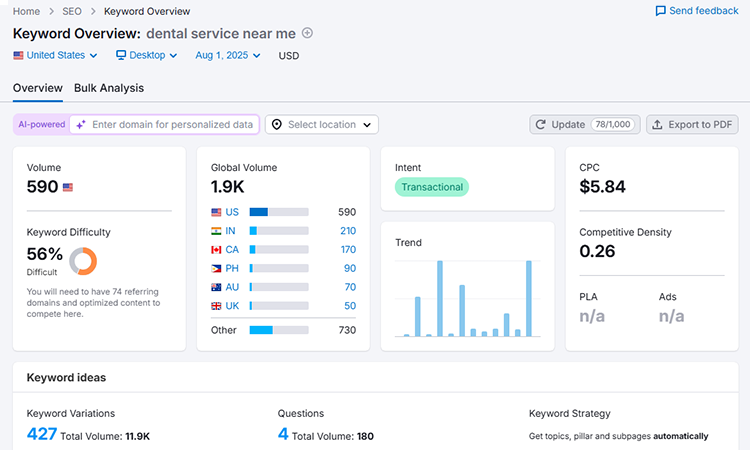
To create an effective ad campaign, start by searching for relevant keywords by implementing tools such as Keyword Planner, SEMrush, and more. However, this is not it. So, this section of the blog will discuss how you can do proper keyword research for your ad campaign.
How to do keyword research:
Keyword research for Google Ads can be time-consuming as well as challenging. However, if you want to conduct a thorough keyword research, do it manually and intentionally. Here are some of the steps you must follow when performing keyword research.
Step 1: Make Sure your SEO Keyword Research Aligns with your Marketing Goals
You will never be able to create an effective ad campaign until you set a clear objective. Ask yourself, what do you want to achieve through this ad campaign? Is it more leads, website traffic, or higher conversion rates?
Step 2: Determine your Base Keywords
This is one of the most crucial steps in the process of keyword research. Find out the core topic or keywords that are closely related to your practice’s products, services, or treatments.
Seed keywords, often known as “short-tail” keywords, are broad search terms of about 1-2 words. These terms usually have high search volumes and competition, and are the bedrock of quality keyword research.
For instance, for a dental business, the seed keyword must include “dental care.” On the other hand, long-tail keywords must include “best dental care in Houston.”
In comparison to the keyword “best dental service in Houston”, the keyword “dental care” has much higher search volume and competition due to its broader appeal.
Step 3: Implement Tools such as Google Keyword Planner and Ubersuggest
There is a wide range of keyword research tools available in the market. You just have to figure out which one is the right one for your practice. So, we have discussed some of the best keyword research tools along with a proper comparison to make your keyword research easier.
- SEMrush
This is one of the most preferred SEO tools, which offers valuable insights into competitors such as their ranking keywords, backlink profile, and more. These insights help businesses understand the kind of keyword competition they are battling against so that they can plan and adjust their strategy effectively.
But do you know, SEMrush has a powerful weapon? That is its keyword magic tool.
This tool provides keywords from a collection of about 800+ million search terms. So, you will get hundreds of keyword ideas with hundreds of metrics attached to them, including their difficulty and search volume.
- Google Keyword Planner
Google Keyword Planner is another renowned research tool that can be easily accessed with any Google account. This tool is a part of the AdWords PPC platform and is completely free.
While it is a great tool for organic search, this tool can also be helpful for setting up successful PPC for dentists as well as discovering keywords. The biggest benefit of Google Keyword Planner? It provides the most accurate results.
However, Google Keyword Planner does exactly what its name suggests: it provides relevant keywords. It does not offer any additional features such as backlink breakdown or traffic analysis.
So, if you are someone who wants to focus on keyword research, then this tool is the right one for you.
- Ubersuggest
This is another affordable tool that offers a basic set of SEO features. Ubersuggest is ideal for beginners as it offers a user-friendly interface.
However, the website audit tool of Ubersuggest lacks advanced features; hence, the results this tool offers are not that accurate.
So, if you are someone who is just starting out, then Ubersuggest is the one for you.
Step 4: Brainstorm Relevant Keywords
As we already know, effective keyword research opens the door for both SEO and PPC success. Start by implementing terms such as “Emergency care near me,” or “Invisalign in Delhi.”
Create separate ad groups for various services to enhance the relevancy of your ads. For instance, create a separate ad for teeth whitening and a separate one for dental implants.
If you are someone who is willing to focus on getting patients from the close proximity of your practice, it is crucial to add location-based keywords such as “teeth cleaning treatment in Texas.”
Step 5: Use Match Types
Broad match: This match type displays ads for a wide range of searches, including synonyms, misspellings, and other closely related variations.
These match keywords are suitable for businesses that are willing to reach a broader group of audiences and boost the visibility of their products or services.
Broad match keywords will show you a wide range of relevant searches that are related to marketing for dental practices. Suppose your keyword is “dental services”.
| Keyword | Intent | Volume | Keyword Difficulty | Competitive Density |
| dental implants | Informational | 135000 | 92 | 0.12 |
| teeth cleaning | Informational | 18100 | 78 | 0.4 |
| best dentist in my area | Commercial | 320 | 61 | 0.48 |
| dental care services | Commercial | 320 | 62 | 0.03 |
| affordable dental treatment | Commercial | 140 | 66 | 0 |
| best dental solutions | Commercial | 20 | 0.23 | |
| local dental clinics | Informational | 20 | 0 |
Phrase match: This match type maintains a perfect balance between exact and broad matches. Phrase match is ideal for businesses that are looking for
With phrase match, your ads will appear for searches that consist of your selected keywords in the same order. This allows for a more refined audience marketing.
| Keyword | Intent | Volume | Keyword Difficulty | Competitive Density |
| Dental braces for adults | Commercial | 2900 | 26 | 0 |
| teeth whitening services | Commercial | 2900 | 28 | 0.05 |
| bleeding gums treatment | Informational | 1600 | 77 | 0 |
| Invisalign treatment near me | Transactional | 1300 | 47 | 0.11 |
| tooth extraction service | Transactional | 10 | 0 |
Exact match:
As the name itself suggests, ads are shown only when someone searches for the exact keyword, guaranteeing a highly targeted audience. Exact matches are an ideal choice for businesses that want precision and specification.
| Keyword | Intent | Volume | Keyword Difficulty | Competitive Density |
| local dentist | Commercial | 8100 | 50 | 0.28 |
| book dentist appointment | Commercial | 170 | 18 | 0.52 |
| dentist in city | Commercial | 20 | n/a | 0.27 |
Strategy 4: Write High-Performing Ad Copy
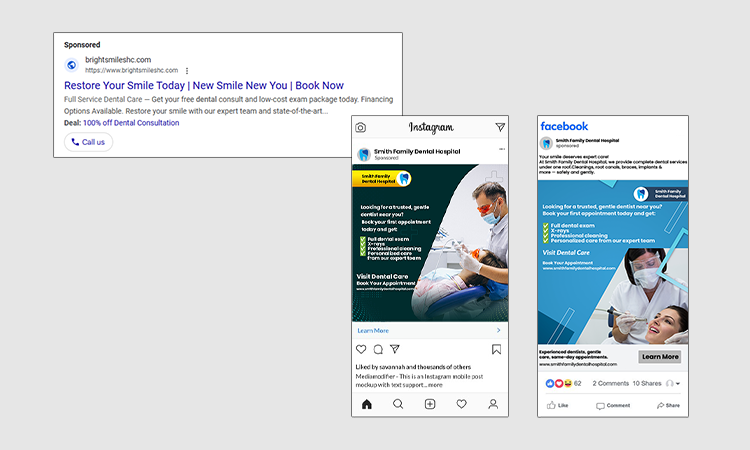
To develop a successful ad campaign, you need to make sure your ad copy is unique and stands out from the others in just 3 seconds. Here is how you can shape the structure of your ad copy in Google and Meta ads.
- Ad Copy Structure for Google:
Before you get creative, you need to understand the technical ground rules to write ad copies for Google Ads.
Make sure to wrap up the headline in not more than 30 characters each. Keep the description to about 90 characters each, and display URL paths offer two 15-character opportunities to support your message.
- Headline 1: Mention Service and Location
The headline is the most crucial part of your ad, as it is what builds the first impression of your ad. Highlight the services or treatments you offer and the location where your practice is based. This allows users to instantly determine whether your ad aligns with their search interest or not.
To establish effective PPC for dentists, make sure to incorporate keywords from your ad group in the headline, as it enhances the relevance of your ad and boosts your ad strength.
Example: You can use a headline such as “Best Teeth Whitening Treatment in Orlando.”
- Headline 2: Focus on Benefit or Trust Signal
You should emphasize how your practice stands out from the others by highlighting key benefits such as “same day appointments,” “24/7 emergency service,” or something like “15 years of experience.”
By showcasing the benefits of taking up your services, you can not only foster trust but also convert prospective leads into loyal patients.
- Description: Develop a Short and Simple Description
Make sure you keep the description of your ad copy crisp, simple, yet engaging. Use clear language and keep the content to the point. Another most important thing about an ad copy is the Call-to-action (CTAs).
You must include a clear and catchy CTA in order to make your potential patients take action, like booking a consultation or making a phone call appointment. Add CTAs such as “Limited Slots Available, Call Now!” or “Get a Free Quote.”
- Ad Copy Structure for Facebook:
Here is a comprehensive guide on how you can create an ad copy structure for Facebook that attracts.
- Headline: Your headline must have the ability to entice your target audience. So, make sure to use a clear and concise headline that instantly strikes.
To make your headline engaging as well as make it reach a broader group of audience, you need to use well-researched keywords. Furthermore, you can also strategically add the benefits of a particular service or treatment.
Make sure to keep the headline short (approximately 40 characters) so that it is properly visible on every device.
- Copy Body: This is another crucial part of your ad copy that you must not ignore. Oftentimes, Facebook users just scroll around, and your ad is very likely to get skipped.
So, use simple language, keep your ad copy short and to the point. Rather than just listing your services and treatments, make sure to include the standout features, benefits, and pain points of your services.
Do not forget to include patient testimonials and reviews, as these are two powerful weapons to foster trust and loyalty among your patients. To create a personalized ad copy, use “you” or “your” in your ad copy to establish a close connection with your patients.
- Call-to-action: Again, CTA is a very important aspect of your ad copy. Failing to create an effective and engaging CTA can make you lose leads. To avoid this, you need to incorporate captivating CTAs in your ad copy.
For designing a good CTA, you need to inform your audience exactly what you want them to do next. For instance, “book now” or “call now.” Make use of strong verbs to trigger immediate action.
Make sure the CTA is placed in a prominent position in your ad copy so it is easily accessible to the viewers.
Strategy 5: Optimize Your Landing Page
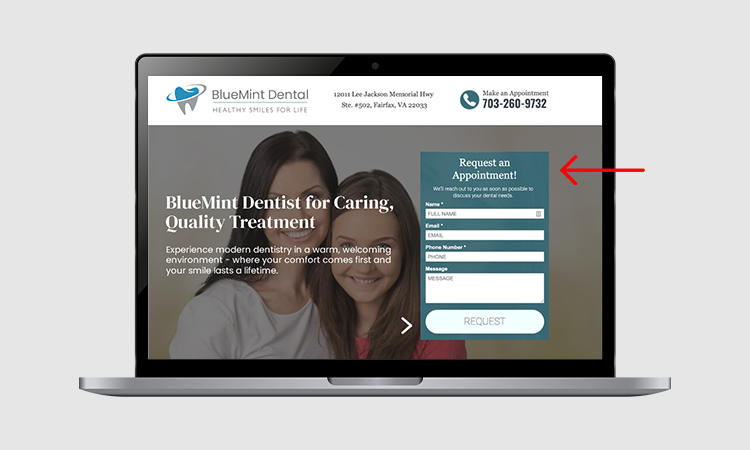
Sending paid traffic to the homepage of your website that has no relevant information related to the ad can lead to high bounce rates, lower conversion rates, and a waste of ad spend.
By creating custom landing pages, dental practices can not only set up high-performing PPC for dentists but also make sure that each of their visitors has a clear path towards becoming loyal patients.
What to include in a dental landing page:
- Clear headline
When designing a landing page, always make sure that your headline perfectly aligns with your ad. Patients should instantly be able to see what they have clicked on.
If your ad talks about “Gentle dental care for babies,” you should optimize your landing page that fortify it with a clear headline and relevant message.
- Service benefits
You must not only focus on features, but also on the benefits of your services or treatments in your landing pages.
Instead of simply adding all your services one by one, briefly explain how those services can help your patients. For example, do not simply go for “Teeth Whitening,” rather use “Show off your bright smile with our teeth whitening services.”
Do not forget to address the common concerns or insecurities of your patients related to dental health. Stress more on the unique value proposition of your services, highlighting how they can enhance dental health and appearance.
- Real patient testimonials
Patient testimonials play a crucial role in every business. Do you know, 77% of people who watched a business’s testimonials agreed that it has played a vital role in convincing them to buy their services or products.
People trust nothing more than real experiences. So, make sure to use real patients rather than using AI-generated videos, as it can cost you a handful of leads.
- Include an Engaging CTA like “Book Now” button above the fold
Make sure to include a CTA that should be instantly visible to your visitors upon landing. This will encourage users to do immediate booking, further maximizing conversion rates.
- Mobile-friendly design
Your landing pages must be highly responsive and perform well on every device, including tablets and smartphones. This is crucial in order to reach a wider audience and enhance user experience.
Tools to Create Effective Landing Pages
If you want to run a successful PPC campaign, you need to create effective and highly functional landing pages. However, creating them is not an easy job. To make the task easier for you, we have jotted down a list of some of the best tools that you can implement to design effective landing pages.
- Unbounce: This is a renowned landing page builder known for its strong focus on Conversion Rate Optimization (CRO). Unbounce allows you to take complete control of your campaigns and conversions and lets you create custom landing pages even if you do not know how to code.
This tool offers a drag-and-drop editor, A/B test landing pages, effective text placement, and AI-powered features such as Smart Copy and Smart Traffic that can help you optimize conversions and page efficiency.
Unbounce is suitable for businesses that prioritize CRO features and are looking to invest in a premium solution.
- WordPress+ Elementor: Elementor is basically a plugin for WordPress that enables users to design and develop websites without the need to know coding. It acts as a visual editor that includes a drag-and-drop interface, making the website-building and customizing process more seamless than ever.
Benefits of using this tool? It offers a drag-and-drop page builder, mobile-responsive editing, as well as high-resolution design. Not only that, but it also offers customizable options, templates, and kits, as well as free and pro versions.
- Leadpages: Ideal for small businesses and entrepreneurs, this tool also offers a user-friendly drag-and-drop builder, special features for lead generation, and a wide range of templates. It highlights the affordability and ease of use. This makes it an uncomplicated and cost-effective tool for designing high-quality landing pages and capturing more leads.
Strategy 6: Set Up and Launch Your Campaign
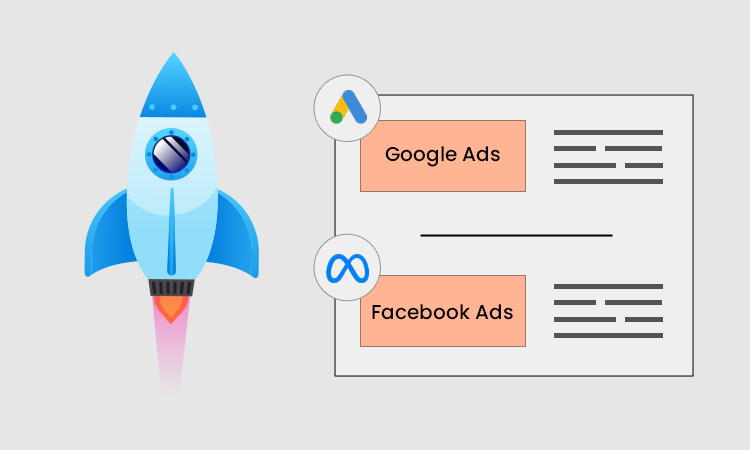
Now that you have everything ready, done with your keyword research, selected the right keywords, planned the structure of your ad copy, and designed your landing pages, it is time for you to set up and launch your ad campaign. So, let’s dive in!
- For Google Ads:
Here is a complete guide for dentists to successfully set up a Google Ads campaign.
- Create your ad group
You can create single or multiple ad groups for your ad campaigns by following the steps listed below.
- Include Individual Ad Groups
In the type list, select “Ad Groups”> In the toolbar, select the “Add Ad Groups” option> When created, select the destination campaign and hit “Ok”>Enter the name of your ad group and one or more bids.
- Add Multiple Ad Groups
In the type list, click on “Ad Groups”> Select “Make multiple changes”> Under the “destination” section, select “My data includes columns for campaigns and/or ad groups, or Use selected destinations”>Type or simply paste your changes into the grid> Click on “Process”> to proceed, click on “Finish and review changes”> If you want to add the pending modification to your account, hit the “Keep”
- Set Daily Budget
To start with effective PPC for dentists, you need to go to a Google Ads account. Click on sign up if you don’t have a Google Ads account, and simply sign in in case you already own one.
From there, go to the “Campaigns” page to set your campaign’s average daily budget. Here is a more detailed breakdown.
You need to navigate to campaigns within the campaign menu> and determine the campaign budget you want to set. In case you are working with a monthly budget, divide that number by 30.4> In the “budget” column, click on the pen icon> Enter a fresh average budget. Start with around $15 to $30 per day> Hit on “Save.”
- Add keywords, ad copy, location targeting, and call extension
For setting up a successful ad campaign, dentists need to add relevant keywords such as “best dentists for children” or “best dental services in Norway” that their target audience is likely to search for. Including these in your ad campaign can make it easier for your ad to reach your target audience.
In the previous sections, we have discussed how ad copy plays a crucial role in the success of your ad campaign. For crafting an eye-catching ad copy, dentists must use short, simple, and catchy headlines that do both, grab attention as well as strategically reflect their products and services.
In case you want to target local patients or patients from a specific location, you can effectively do it by location targeting. First, you need to identify the geographic regions where you want your ad campaign to be displayed.
For most campaign types, you can select locations to show your ads. For instance, you can choose a particular city, state, and country, or even a radius around a location. To successfully make your ads appear to your local audience, you can leverage keywords such as “best dental services near me,” or “best dentists in the USA.”
By implementing a call extension in their ad campaign, dentists can allow patients to connect with them directly from the search result pages. Dentists can also leverage call tracking tools to determine the performance of their call extension.
- For Meta Ads:
- Set Up your Ad Account
For setting up Facebook or Instagram ads, you need to create a dental ad account on Ad Manager.
Firstly, create a business page> Once created, navigate to Meta Ads Manager to create an ad account> To run your first ad, you will need to choose a payment method> Navigate to the “Payment Settings” section in the Ad Manager> Choose the option you want to go with, PayPal, Credit cards, or bank transfer.
- Choose your Campaign Objective
After you are done setting up your ad account, it is time for you to choose your campaign objective. Remember, this is one of the most vital parts of setting up Meta Ads. Selecting an ad objective is important to make sure your Meta ads align perfectly with your business goals.
For selecting an ad objective, you need to determine what you want to achieve through this campaign. Do you want to enhance your brand awareness, maximize lead generation, or drive website traffic? Setting up a proper objective can help Facebook optimize your ad delivery so that you can get the desired results.
- Define your audience:
To set up result-driven PPC for dentists, the key is to identify your target audience. Meta offers modern targeting tools that can help you reach a highly-specific group of audience based on location, age, interests, dental concerns, and more.
By understanding the audience, dentists will be able to boost their brand awareness as well as drive effective results.
- Include Visual Elements and Set your Budget Plan
It is quite difficult to attract an audience, especially when the topic is healthcare. A dentist’s ad campaign needs to be engaging enough to capture the attention of patients. No matter how catchy your headline or body of content is, if you are not using any visual elements, then you are doing it all wrong.
Include attention-grabbing visuals such as videos or images in your ads to make more patients interact with them.
Lastly, you will need to determine a budget and set a schedule for Meta ads. This is crucial for managing your ad budget and guaranteeing that your ad is reaching the audience at the right time.
When setting an ad budget, dentists are provided with two options. They can either set up a monthly budget or a lifetime budget. A daily budget sets the amount you are looking to spend daily. On the other hand, the lifetime budget is the maximum amount of money you are looking to spend over the complete ad campaign duration.
Once you are done choosing your budget type, you need to establish your ad schedule. Again, Meta will provide you with two options. You can either choose the start and end dates of your ad or run it constantly without any end dates.
For special promotion ads or ads that are related to a specific event, it is best to schedule the exact dates.
- Launch your Ad Campaign
Now that you have completed setting up your Facebook or Instagram ad, it is time to launch it. However, that is not it. You cannot simply launch your ad and get busy with other stuff.
You need to monitor its performance. After you are done launching the campaign, keep track of its effectiveness and whether it is driving the desired results. In case you have no idea where to start or you are too busy to keep track of your campaign performance, you can perhaps hire a professional PPC marketing service.
- For Microsoft Ads:
To successfully set up an ad campaign on Microsoft Ads, you need to follow the below-mentioned steps below.
Finally, click on “Submit” and launch your ad campaign.
- Firstly, you must sign in to your Microsoft Account. Once you are done signing in, you will be provided with three options: “Create account,” “Import from Google Ads,” and “Import from Meta Ads.”
- In case you do not have an account with Google or Meta Ads, click on “Create account.” If you already own an account on either of these platforms, you may simply choose to import campaigns directly from these platforms.
- After that, you need to select the country where you are based or your business is located and the language you would like to be advertised in, and hit the “Next” button.
- If you have a website, select “I have a website,” and then you need to enter the main URL of the website. In case you do not have a website, simply click on “I don’t have a website” and click on “Next.”
- Once you are done with everything, choose whether you want to “Create account and campaign” or “Create account only.”
- You need to go through your ads. If you have provided the URL of your website, Microsoft will automatically fetch information from the same to fill in the data on your ads. If not, you will need to add relevant details manually. Add or edit information if needed for your short headlines, descriptions, business name, or final URL, and click on “Next.”
- As a dental practice, this is the most crucial step for you. Choosing the right audience you want to target. For this, you need to determine who and where you want to show your ads. Click on “Next” once you are done.
- Now it is time for you to set a daily budget. Pick the bid strategy. Based on the bid strategy you selected, you can optionally set a Target Return on Ad Spend or Target CPA (Cost Per Acquisition). Once you are done, click on “Next.”
- After this, you need to choose your billing country/region. Once done, choose a payment method and payment settings.
- Before paying, you must carefully review the terms and conditions of Microsoft ads and select the box if you agree with them.
Strategy 7: Track Your Results with Analytics

Apart from taking up a dental PPC advertising service, you can also implement some advanced tracking tools such as,
- Google Ads dashboard: This tool is great for tracking KPIs (Key Performance Indicators) such as Cost-per-click, conversion rates, and impressions.
- Google Analytics: You can implement Google Analytics to keep track of bounce rates and form submissions.
- Meta Ads Manager: This tool is ideal for businesses that are looking to monitor their reach, click-through-rate (CTR), and number of leads generated from their Meta campaigns.
Key Metrics to Monitor:
Here are some key metrics you must keep track of after launching your ad campaign.
- Cost per lead (CPL): This metric helps businesses determine how much they are spending to get a single lead.
- Click-through rate (CTR): Click-through rate is calculated as clicks divided by impressions. A higher CTR signifies that your ads are interactive.
- Conversion rate (CVR): Conversion rate is measured by the percentage of users who complete an action, such as scheduling an appointment or submitting a form, after clicking your ad.
Strategy 8: Optimize Your Campaigns Weekly
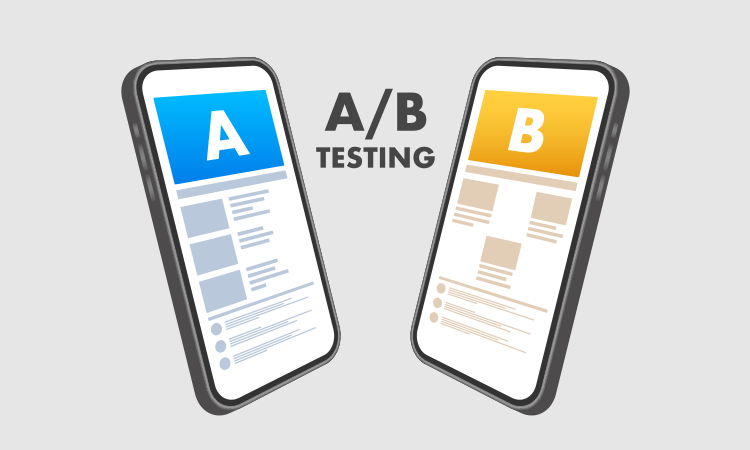
PPC is not a set-it-and-forget-it tool; it is crucial to closely monitor and manage PPC for dentists. Here’s how you can do it.
- Avoid Underperforming Keywords/Ads: Make sure to identify keywords or ads that are not performing up to the mark or are not meeting your desired goal or objective, and pause them to save money and overall effectiveness of your ad campaigns.
- A/B Testing: Test with different ad descriptions, headlines, and CTAs to confirm whether they align with their audience. Adjust your Bids: You should adjust your bidding strategy or bids based on performance data. Consider increasing your bids for high-performing lowering them for ads that are not performing well.
- Check ad relevance score & quality score: Make sure your ads are relevant to what your target audience is looking for. Furthermore, your landing pages must be optimized for a better user experience. A high quality score can place your ad in a prominent position as well as lead to lower ad spend.
Bonus: Retargeting and Local Ad Extensions
- Retargeting:
You should reach out to patients who have expressed their interest in your products, services, or businesses or have visited your website in the past but have not converted.
Offer special discounts, deals, or reminders to encourage them to return and schedule an appointment or book a slot via phone call.
- Local Extensions:
If you have a walk-in clinic, you can add local extensions to your ads, such as your phone number, address, and map, to enhance business visibility as well as mobile performance.
Best Platforms to Run PPC Ads for Dental Practices
Here is a list of some of the best Ad platforms that dentists can leverage to successfully run PPC ads.
Google Ads is one of the most preferred online advertising platforms for dentists. It helps them attract patients exactly when they are looking for dental services.
This platform is known for generating immediate results (within an hour of launch). Through effective location, time-of-day, and device targeting, Google Ads guarantees cost-effectiveness.
Not only that, but Google Ads offers precise data, making campaign optimization easy. The integration of Google Business Profile improves local visibility.
- Facebook and Instagram
Meta platforms such as Facebook and Instagram are great advertising platforms that help in establishing brand awareness and showcasing the principles and values of your practice through visual elements. With almost the entire population using these platforms, it makes it perfect for offering exceptional reach for dental practices.
The before/after videos or images of patients can boost engagement. Meta platforms often target their interests, demographics, behaviors, and lookalike audiences.
In comparison to Google, Meta platforms have a lower cost-per-impression, making them an ideal advertising platform for startup businesses.
- Bing
This is a very underrated platform, but it can be very effective to set up successful PPC for dentists. By devoting a small budget to Bing Ads, you can reach a broader audience and boost your ROI.
Bing has comparatively lower competition and CPC than any other ad platform, which is why running ads on this platform can increase the chances of capturing more attention and bringing in high-quality traffic to your website.
This ad platform is one of the best advertising platforms for dentistry businesses. Develop engaging posts and articles that highlight your expertise and establish brand awareness.
By running interactive PPC ads on LinkedIn, you can not only attract new patients who are looking for an experienced dentist or dental clinics for their dental needs.
- YouTube
Through engaging and educational video content, YouTube can be used as a great platform to promote your dental practice. By developing captivating and informative ad campaigns, you can reach a wide range of prospective audiences.
How Can Dentists Choose a PPC Agency That Specializes in PPC Advertising
Pay-per-click advertising, the name might sound simple. However, the process is not that simple. For creating and running an effective ad campaign, knowing just the basics of PPC won’t work.
Furthermore, it can be quite tiring to manage a dental clinic and to keep track of your campaign performance at the same time. Partnering with a dental PPC marketing agency can not only save your time but also allow you to focus on more important tasks.
However, with so many PPC agencies out there, how will you figure out which one is the best for you? Don’t worry, we have got you covered. This section of the blog will discuss some major points you need to consider when choosing a PPC agency for your dental practice.
Hiring a dental PPC agency
- Run a Thorough Background Check
Before hiring a dental PPC agency, you need to conduct a thorough background check to confirm their process, qualifications, and relevant certifications. Make sure to look for real reviews, case studies, and client testimonials that highlight the effectiveness of their process and knowledge of the dentistry industry.
Do not forget to access the ability of the agency to deliver successful results, such as higher website traffic, enhanced ROI, and higher conversion rates.
- Evaluate their Industry Knowledge
Go for an agency that has a proven track record of success in the dental marketing field. This will make it easier for you to understand the challenges and opportunities of dental marketing.
When choosing a PPC agency for your dental practice, you need to make sure they understand your target audience and are implementing the right keywords to attract your them. A good agency should be able to effectively showcase your Unique Selling Points (USPs) to help you stand out in the highly crowded market.
- Assess their Success Stories and Client Testimonials
You need to evaluate key assets such as success stories and client testimonials to make sure they have driven successful results for their other clients. Do not go for an agency that uses AI-generated patient testimonials or showcases their case studies without relevant proof.
- Determine their Strategies and Approach
When choosing a PPC agency, this is one of the most crucial points you need to consider. Make sure the agency you are choosing understands your business goals and offers a personalized solution rather than following a one-size-fits-all approach. Evaluate their process of working and the strategies they are implementing to ensure they align with your marketing goals.
- Ensure Transparency in Communications
Transparency is the key to a successful partnership. Confirm that the agency you are going with communicates transparently, answers your queries, responds promptly, and provides valuable insights on how your campaign is performing.
They should share updated and regular data reports on campaign effectiveness, including key metrics such as ROAS, Cost-per-acquisition (CPA), and conversion rates. Furthermore, the agency you are choosing must be able to adjust its strategies or process of working based on your insights and feedback.
Final Thoughts
PPC for dentists can be very effective if done right. Unlike SEO and SMM, PPC ads provide instant results, which makes it ideal for businesses that are willing to get positive yet immediate results. Pay-per-click advertising can position your practice at the top of the search engine rankings and help you reach the right audience at the right time. By creating and running successful ad campaigns, implementing effective tracking tools, and developing high-converting landing pages, you can not only boost your brand awareness but also maximize conversion rates. Finding PPC too complicated? You can simply hire a dental PPC marketing agency.



























